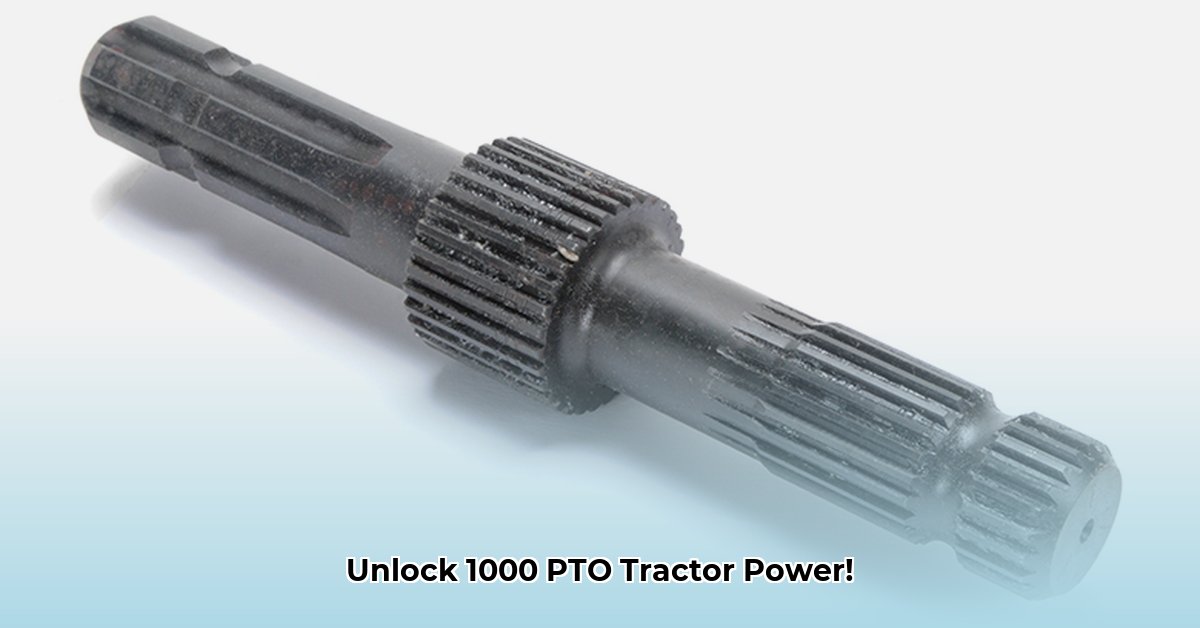
Harnessing the power of a 1000 RPM PTO (Power Take-Off) tractor can significantly increase your farm's productivity. However, understanding its unique characteristics and safety protocols is crucial before operation. This guide provides a comprehensive overview to help you maximize efficiency and minimize risks. For additional implement options, check out tractor implements.
Understanding the Power Take-Off (PTO): Your Tractor's Workhorse
The PTO is your tractor's power transmission system—a spinning shaft that delivers engine power to implements like hay balers and tillers. A 1000 RPM PTO tractor spins this shaft at 1000 revolutions per minute (RPM), compared to the more common 540 RPM. This higher speed translates to increased output and faster task completion. But this increased speed also demands extra attention to safety precautions.
Why Choose a 1000 PTO Tractor? The Advantages
The higher RPM of a 1000 PTO tractor directly translates to increased productivity. This is particularly advantageous for tasks requiring high-speed processing, such as chopping silage or operating high-capacity irrigation pumps. "A 1000 RPM PTO can easily double the throughput of several common agricultural tasks compared to a 540 RPM system," notes Dr. Amelia Hernandez, Agricultural Engineering Professor at the University of California, Davis. This increased efficiency can lead to significant time and cost savings. Have you ever calculated how much labor costs you could save by completing tasks faster?
| Advantage | Detailed Explanation |
|---|---|
| Increased Productivity | Higher RPM leads to significantly faster operation, completing tasks more quickly. |
| Ideal for Specific Tasks | Perfect for high-capacity equipment like forage harvesters and large-scale pumps. |
| Potential Fuel Savings | In some cases, increased efficiency may result in improved fuel economy; however, this depends on various operational factors. |
| Reduced Labor Costs | Faster task completion translates to less labor time and lower overall labor costs. |
Potential Downsides: Compatibility is Key
A crucial consideration is compatibility. Not all implements are designed for 1000 RPM operation. Attempting to use a 540 RPM implement with a 1000 RPM PTO can result in serious equipment damage and pose significant safety risks. Always consult your implement's manual before connecting it to your tractor. Ignoring this could lead to costly repairs and potentially dangerous situations.
Safe Operation: A Step-by-Step Guide for Success
Prioritizing safety is paramount. Always adhere to these steps:
Compatibility Check: Verify implement compatibility with 1000 RPM operation before connection.
PTO Shaft Inspection: Conduct a thorough visual inspection of the PTO shaft for wear, damage, or loose connections. Replace or repair any issues before operation.
Smooth Engagement: Engage the PTO slowly and smoothly. Avoid abrupt movements.
Secure Attachments: Ensure the implement is firmly attached and locked in place before starting work.
Safety Gear: Always wear appropriate safety gear, including gloves, eye protection, and hearing protection.
Careful Disengagement: Disengage the PTO slowly and carefully, ensuring complete stoppage before handling any equipment.
Bridging the Gap: Adapters and Alternative Solutions
For older 540 RPM implements, adapters might be considered. However, use only those from reputable manufacturers and ensure correct installation. Improperly installed adapters dramatically heighten accident risks.
Choosing the Right PTO System: 540 RPM vs. 1000 RPM
The optimal choice (540 or 1000 RPM) depends on individual farm needs and equipment compatibility. High-capacity implements benefit from 1000 RPM's increased speed and efficiency. However, for older equipment, 540 RPM might be safer and more practical. Prioritize safety; it underpins a productive and safe farming operation. Technological advancements continuously reshape agricultural best practices.
How to Safely Adapt Non-Standard Agricultural Tractor PTO Shafts
Adapting non-standard PTO shafts necessitates meticulous care due to the increased risk of accidents. Improper adaptation can severely compromise both safety and equipment longevity.
Step 1: Identify Compatibility Issues: Thoroughly assess differences between the shaft and your tractor/implement specifications.
Step 2: Consult Manuals: Check for authorized adapters or alternative solutions provided by manufacturers.
Step 3: Adapter Selection (If Necessary): Choose high-quality, purpose-built adapters from reliable suppliers to avoid compromising safety.
Step 4: Careful Installation: Install the adapter and PTO shaft precisely, paying close attention to alignment and security.
Step 5: Thorough Inspection: Before engaging, meticulously inspect the whole assembly for flaws or misalignments.
Step 6: Initial Test Run: Start the PTO at low speed and carefully monitor for unusual vibrations or noises. Immediately stop if issues arise.
Step 7: Regular Maintenance: Regularly inspect the PTO shaft for wear and tear to prevent potential problems.
Safety Considerations for 1000 PTO Systems
- Guards: Maintain proper PTO shaft guards to mitigate entanglement risks.
- Training: Comprehensive training on safe PTO operation and maintenance is non-negotiable.
- Maintenance: Regularly inspect for wear and tear and promptly replace worn parts.
- Emergency Shut-Off: Familiarize yourself with the tractor's emergency shut-off system.
Pros and Cons of Adapting Non-Standard PTO Shafts
| Feature | Pros | Cons |
|---|---|---|
| Adapting PTO Shafts | Enables use of implements initially incompatible with the tractor. | Heightened accident risk if improperly executed. May void warranties. Can lead to reduced efficiency. |